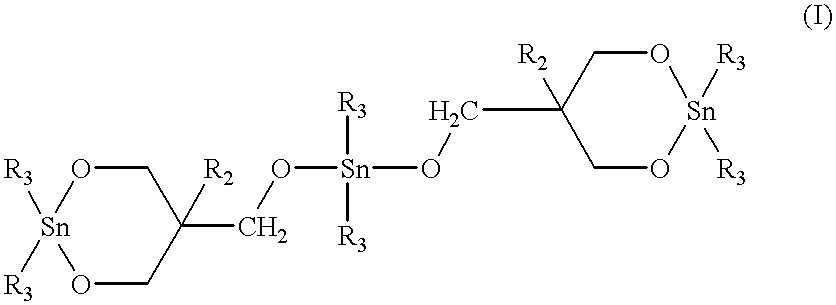Blend material including macrocyclic polyester oligomers and processes for polymerizing the same
a technology of polyester oligomers and dyed materials, which is applied in the field of dyed materials including macrocyclic polyester oligomers and processes for polymerizing the same, can solve the problems of limited development of processing equipment for use limited application of macrocyclic polyester oligomers, and high cost of modification of existing equipmen
- Summary
- Abstract
- Description
- Claims
- Application Information
AI Technical Summary
Problems solved by technology
Method used
Image
Examples
example 1
Twenty milligrams of 1,1,6,6-tetra-n-butyl-1,6-stanna-2,5,7,10-oxacyclodecane ("stannoxane-1") was dissolved with heating in approximately 2.5 ml of toluene which had been pre-dried by treating with 4A molecular sieves. The solution was cooled and poured into a glass jar containing 5.0 g of finely pulverized macrocyclic copolyester oligomer of PBT / PE (95 / 5 molar ratio). After intimately mixing the resulting uniform paste was dried under vacuum at about 50.degree. C. The white crusty solid was pulverized by using a pestle and a mortar. The resulting uniform free flowing white powder contained 0.3 mole % of tin atoms per mole of the copolyester monomer repeat units.
example 2
Example 1 was repeated except that 33.0 mg of stannoxane-1 catalyst was employed to give a blend containing 0.5 mole % of tin atoms per mole of the copolyester monomer repeat units.
example 3
Di-n-butyltin oxide (24.89 g, 0.100 mole), 2,2-diethyl-1,3-propanediol (13.22 g, 0.100 mole) and 75 ml of toluene were placed in a 250 ml, three necked flask equipped with a Dean-Stark condenser. The mixture was stirred under nitrogen and heated to reflux for approximately 2 hours during which time approximately 1.7 ml of water was separated. The Dean-Stark condenser was replaced with another Dean Stark condenser filled with molecular sieves. The reaction mixture was further heated to reflux for an additional hour and then approximately 60 ml of the toluene was distilled off. Upon cooling, a white crystalline solid was obtained. The yield of 1,1-di-n-butyl-4,4-diethyl-1-stanna-2,5-dioxacyclohexane ("stannoxane-2") was 36.1 g.
PUM
| Property | Measurement | Unit |
|---|---|---|
| Fraction | aaaaa | aaaaa |
| Fraction | aaaaa | aaaaa |
| Time | aaaaa | aaaaa |
Abstract
Description
Claims
Application Information
 Login to View More
Login to View More - R&D
- Intellectual Property
- Life Sciences
- Materials
- Tech Scout
- Unparalleled Data Quality
- Higher Quality Content
- 60% Fewer Hallucinations
Browse by: Latest US Patents, China's latest patents, Technical Efficacy Thesaurus, Application Domain, Technology Topic, Popular Technical Reports.
© 2025 PatSnap. All rights reserved.Legal|Privacy policy|Modern Slavery Act Transparency Statement|Sitemap|About US| Contact US: help@patsnap.com



